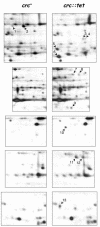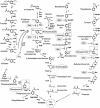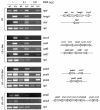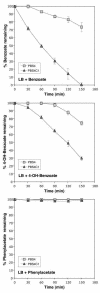The Pseudomonas putida Crc global regulator controls the expression of genes from several chromosomal catabolic pathways for aromatic compounds
- PMID: 14973036
- PMCID: PMC344427
- DOI: 10.1128/JB.186.5.1337-1344.2004
The Pseudomonas putida Crc global regulator controls the expression of genes from several chromosomal catabolic pathways for aromatic compounds
Abstract
The Crc protein is involved in the repression of several catabolic pathways for the assimilation of some sugars, nitrogenated compounds, and hydrocarbons in Pseudomonas putida and Pseudomonas aeruginosa when other preferred carbon sources are present in the culture medium (catabolic repression). Crc appears to be a component of a signal transduction pathway modulating carbon metabolism in pseudomonads, although its mode of action is unknown. To better understand the role of Crc, the proteome profile of two otherwise isogenic P. putida strains containing either a wild-type or an inactivated crc allele was compared. The results showed that Crc is involved in the catabolic repression of the hpd and hmgA genes from the homogentisate pathway, one of the central catabolic pathways for aromatic compounds that is used to assimilate intermediates derived from the oxidation of phenylalanine, tyrosine, and several aromatic hydrocarbons. This led us to analyze whether Crc also regulates the expression of the other central catabolic pathways for aromatic compounds present in P. putida. It was found that genes required to assimilate benzoate through the catechol pathway (benA and catBCA) and 4-OH-benzoate through the protocatechuate pathway (pobA and pcaHG) are also negatively modulated by Crc. However, the pathway for phenylacetate appeared to be unaffected by Crc. These results expand the influence of Crc to pathways used to assimilate several aromatic compounds, which highlights its importance as a master regulator of carbon metabolism in P. putida.
Figures




Similar articles
-
The translational repressor Crc controls the Pseudomonas putida benzoate and alkane catabolic pathways using a multi-tier regulation strategy.Environ Microbiol. 2013 Jan;15(1):227-41. doi: 10.1111/j.1462-2920.2012.02863.x. Epub 2012 Aug 28. Environ Microbiol. 2013. PMID: 22925411
-
Genomic analysis of the aromatic catabolic pathways from Pseudomonas putida KT2440.Environ Microbiol. 2002 Dec;4(12):824-41. doi: 10.1046/j.1462-2920.2002.00370.x. Environ Microbiol. 2002. PMID: 12534466
-
Levels and activity of the Pseudomonas putida global regulatory protein Crc vary according to growth conditions.J Bacteriol. 2005 Jun;187(11):3678-86. doi: 10.1128/JB.187.11.3678-3686.2005. J Bacteriol. 2005. PMID: 15901690 Free PMC article.
-
Transcriptional control of the Pseudomonas TOL plasmid catabolic operons is achieved through an interplay of host factors and plasmid-encoded regulators.Annu Rev Microbiol. 1997;51:341-73. doi: 10.1146/annurev.micro.51.1.341. Annu Rev Microbiol. 1997. PMID: 9343354 Review.
-
Transcriptional control of the Pseudomonas putida TOL plasmid catabolic pathways.Mol Microbiol. 1993 Sep;9(5):923-9. doi: 10.1111/j.1365-2958.1993.tb01222.x. Mol Microbiol. 1993. PMID: 7934920 Review.
Cited by
-
The global regulator Crc plays a multifaceted role in modulation of type III secretion system in Pseudomonas aeruginosa.Microbiologyopen. 2013 Feb;2(1):161-72. doi: 10.1002/mbo3.54. Epub 2013 Jan 4. Microbiologyopen. 2013. PMID: 23292701 Free PMC article.
-
Inactivation of Pseudomonas putida KT2440 pyruvate dehydrogenase relieves catabolite repression and improves the usefulness of this strain for degrading aromatic compounds.Microb Biotechnol. 2024 Jun;17(6):e14514. doi: 10.1111/1751-7915.14514. Microb Biotechnol. 2024. PMID: 38923400 Free PMC article.
-
Global regulation of food supply by Pseudomonas putida DOT-T1E.J Bacteriol. 2010 Apr;192(8):2169-81. doi: 10.1128/JB.01129-09. Epub 2010 Feb 5. J Bacteriol. 2010. PMID: 20139187 Free PMC article.
-
Anaerobic catabolism of aromatic compounds: a genetic and genomic view.Microbiol Mol Biol Rev. 2009 Mar;73(1):71-133. doi: 10.1128/MMBR.00021-08. Microbiol Mol Biol Rev. 2009. PMID: 19258534 Free PMC article. Review.
-
New insights on the reorganization of gene transcription in Pseudomonas putida KT2440 at elevated pressure.Microb Cell Fact. 2013 Mar 28;12:30. doi: 10.1186/1475-2859-12-30. Microb Cell Fact. 2013. PMID: 23537069 Free PMC article.
References
-
- Bertani, I., M. Kojic, and V. Venturi. 2001. Regulation of the p-hydroxybenzoic acid hydroxylase gene (pobA) in plant-growth-promoting Pseudomonas putida WCS358. Microbiology 147:1611-1620. - PubMed
-
- Cases, I., and V. de Lorenzo. 1998. Expression systems and physiological control of promoter activity in bacteria. Curr. Opin. Microbiol. 1:303-310. - PubMed
-
- Collier, D. N., P. W. Hager, and P. V. Phibbs, Jr. 1996. Catabolite repression control in Pseudomonads. Res. Microbiol. 147:551-561. - PubMed
Publication types
MeSH terms
Substances
LinkOut - more resources
Full Text Sources
Other Literature Sources

